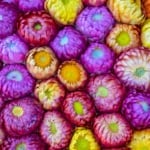How To Grow And Care For Strawflowers, An Everlasting Beauty
A colorful member of the aster family, strawflowers are easy to grow and a pollinator favorite—they'll be your "everlasting" favorite, too!

Mother Nature never ceases to amaze with the number of beautiful flowers available for us to enjoy. With a dizzying array of shades and scents to brighten our moods and decorate our living spaces, it can be a hard choice to decide which ones to grow each spring. If you are looking for a robust flower that comes in a wide variety of rich colors and plentiful blossoms, take a closer look at strawflowers. Not only do these flowers enliven fresh bouquets, but they can also be easily dried—they are known as “everlastings” because they retain their color and shape long after harvest thanks to their singular petal-like bracts that form each bloom.
What Are Strawflowers?

While the name might not be familiar, you’ve certainly seen these sunny beauties just about everywhere, from spring arrangements to fall bouquets. They are a member of the aster family and for a couple of centuries were known by the scientific name Helichrysum bracteatum. But then two new names were introduced as the plant was reclassified: Bracteantha bracteata and Xerochrysum bracteatum, with the latter winning the taxonomic battle—its name derived from the Greek xeros for dry, and chrysum for golden, with bracteatum meaning the bracts of the flower itself.
At first glance, strawflower blooms look similar to mums, but giving them a slight touch gives them away—the bracts of a strawflower feel like stiff paper even when the flower first opens, giving it a head start as an everlasting.
Strawflower Symbolism
Because this flower retains its color and shape for so long, it is considered a symbol of immortality. Strawflowers also represent someone or something that is “always remembered.”
Want To Grow Strawflowers? Here’s How

Imagine a garden full of these colorful beauties! Fortunately, growing strawflowers is less confusing than their taxonomy. This Australian native is drought- and heat-tolerant, which is a godsend for those living in hot, arid climates who long for a beautiful flower garden. They will grow more vigorously with sufficient water and moderate temperatures, however. The plant thrives in good, healthy soil with adequate drainage and full sun, and can also tolerate some light shade, so they’re a perfect choice for just about any growing climate.
Most often, strawflower seeds are sold as a color mix, although individual shades now can be found, such as white, apricot, pink, yellow, orange, and red. Oftentimes, the inside of the bracts will sport secondary contrasting colors when the bloom is fully open, such as red with yellow or deep pink with white for a truly stunning appearance.
Strawflower varieties range from dwarf sizes of under 15 inches tall to the standard size of about three feet. The larger varieties may need supports to stay upright. Individual plants can have a spread of up to 18 inches, although the trick to aiding this comes from deadheading, or removing the spent or faded blooms before they can develop seeds. The more the plant is pinched back, the bushier it will grow, sending out more side shoots.
Start Seeds Indoors

Strawflower can be sown directly into the garden after all threat of frost has passed, although this method is not recommended for short-season gardens for a couple of reasons. Maturity for most strawflower varieties is around 85 days, which would limit the bloom time for more northerly growers. Secondly, seed germination is optimal above 70 degrees, which can be difficult to achieve in the spring, again, for those of us in northerly climes.
The most reliable way to grow strawflowers is to start seeds indoors, three to six weeks before the last frost. Light is needed for germination, so do not cover the seeds with soil. After the first true leaves appear, transplant to a larger container until the threat of frost has passed, then transplant the seedlings to the garden, spacing plants 10 to 12 inches apart.
Strawflowers should be treated as an annual, although there are perennial varieties. They are hardy in USDA hardiness zones 8 to 10 where they can reach up to five feet in height, making them a great addition to your cutting flower garden. Occasionally, plants may reseed themselves, although cultivars will not grow true from self-seeding.
Pollinators Love Them!


And you won’t be the only one to appreciate them—many of our pollinator friends, such as butterflies, bees, and hoverflies are highly attracted to strawflowers. In fact, we include them in our list of flowers to plant to attract butterflies to your garden!
Don’t forget to check our Gardening by the Moon planner to pick the best day to start seeds!
How To Dry Strawflowers

To dry strawflowers, harvest when only the first two or three bract layers have unfurled, and when the morning dew has evaporated off the flowers.
As an everlasting, strawflower retains its color and shape well, although the bracts are easily broken if not handled carefully. The stems are even more susceptible to breaking, but that can be remedied by removing the stem entirely before drying, replacing it with floral wire inserted into the base of the flower.
If you’re leaving the stem intact, be sure to remove any leaves from the stem prior to tying them together with twine. Hang the bundle upside down, away from sunlight in a cool, dry space with sufficient airflow for two to three weeks.

Once the flowers are dried, they can be wrapped in newspaper or tissue paper and stored in a box for up to a year if they are not to be used in arrangements immediately. This will help protect them from dust as well as fading from light exposure. Despite the “everlasting” moniker, the color will fade with time, and the dried flowers will become more brittle as they age.
Keeping arrangements out of the sunshine will prolong their luster through the winter months until fresh strawflowers can be grown again.

Janine Pineo
Janine Pineo has been gardening all her life in Maine and writing about it for more than two decades. More of her writing can be found on her website, GardenMaine.com.






RE Snow 6 weeks after thunderstorms. We have had rain here in NEPA,but no thunder have I heard all summer. Maybe we won’t have snow?
Thank you for this information. I am very interested in trying out this flower in my garden which is sunny and hot as hades, north Texas…
Thank you for the information Janine. It is much appreciated. I love strawflowers and pretty much all the others! Regards to you.